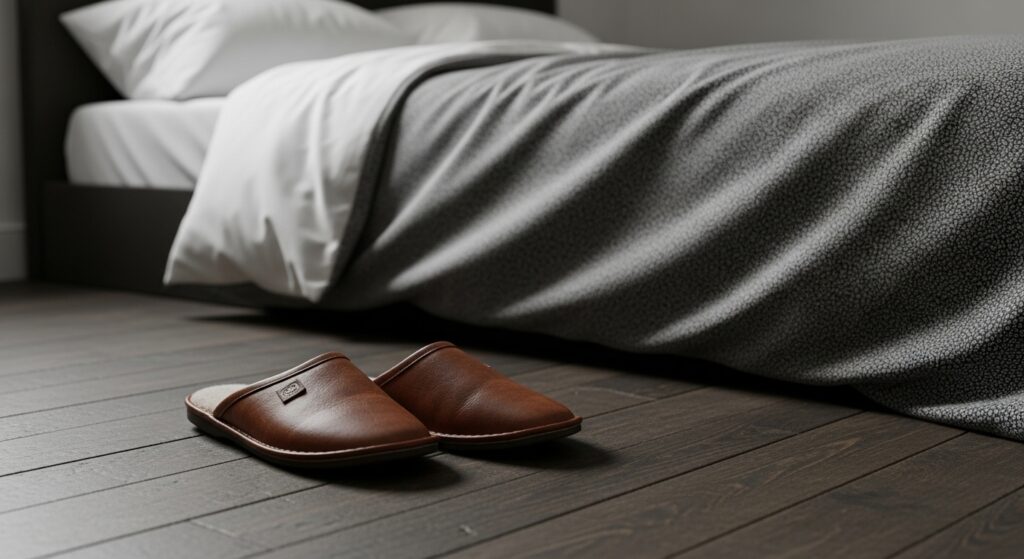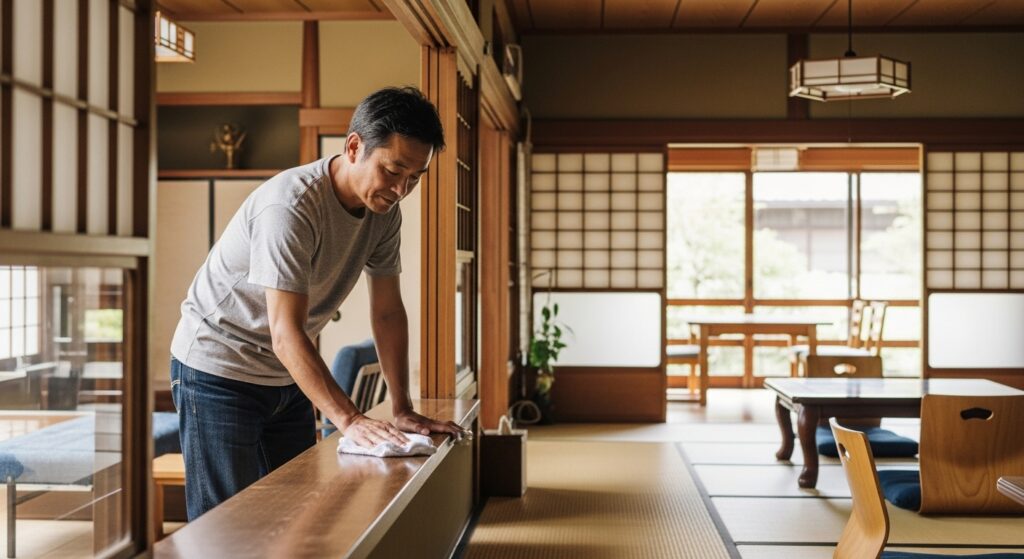Embrace the Spirit of Kiyomeru: Cleanliness as Purification
In Japan, cleaning is much more than just tidying up — it’s a spiritual practice called Kiyomeru (清める). This mindset teaches us that cleaning is about creating harmony and balance, not just removing dirt. When you clean with this spirit, you’re not only making your home physically cleaner but also purifying the energy around you. This Japanese House Cleaning approach helps bring calm and positivity to your living space, transforming everyday chores into a mindful ritual.
Seeing cleaning as a way to connect with your surroundings shifts your attitude. Instead of feeling like a task, it becomes a form of respect for your home and yourself. This deeper view encourages regular care and appreciation, making your house a place of peace and renewal. By embracing Kiyomeru, cleaning stops being a burden and starts being a meaningful part of daily life.
Keep a Dedicated Pair of Slippers for Each Room
In Japanese homes, it’s common to have a dedicated pair of slippers for each room to stop dirt from spreading throughout the house. This simple habit helps keep floors cleaner and reduces the need for constant sweeping or mopping. By changing slippers when moving from room to room, you’re actively preventing outside dust and grime from traveling inside.
A handy bonus tip is to try mop slippers—these are slippers with cleaning pads underneath that allow you to gently wipe and clean the floor as you walk around. This way, cleaning becomes easier and more natural, blending seamlessly with your daily movements.

Practice the “One In, One Out” Rule: Toss an Old Item After Buying New
A key part of Japanese house cleaning tips is following the “one in, one out” rule. Every time you bring in a new item, whether it’s clothing, kitchenware, or decor, it’s important to toss an old one. This simple practice helps prevent clutter from piling up and keeps your home feeling spacious and calm.
This habit supports a minimalist lifestyle and promotes mental calm by reducing unnecessary possessions. Letting go of things that no longer serve you can bring peace to your space and mind, making cleaning less overwhelming and more rewarding.
Start with Daily Quick Cleaning Rituals
In Japanese homes, maintaining a clean space often starts with a simple 10-minute daily cleaning habit. This quick routine focuses on easy tasks like wiping down surfaces, doing a bit of dusting, and tidying up small messes. Doing a little each day prevents dirt and clutter from building up, keeping your home fresh and organized without feeling overwhelming.
By making these short cleaning sessions a consistent part of your day, you build a habit that supports a calm, harmonious environment. It’s an effective way to manage house cleaning while freeing up time for the things you enjoy.
Clean Windows and Screens Regularly to Invite Fresh Air
Keeping windows and flyscreens clean is an important part of Japanese house cleaning. Sparkling windows let in plenty of natural light and fresh air, which helps create a positive energy flow throughout the home. Regularly washing and dusting these areas, especially during seasonal changes, refreshes both your space and your mind.
Clean windows also prevent dust and pollen buildup, improving air quality inside your home. This simple habit connects your living space with nature’s rhythms and promotes harmony within.

Wash Pans and Dishes Immediately After Cooking
In Japanese homes, washing pans and dishes right after cooking is a common practice that keeps the kitchen tidy and prevents the buildup of grease and grime. This habit saves time later and helps maintain an organized, efficient cooking space.
By cleaning as you go, you avoid letting dirty dishes pile up, making kitchen chores less overwhelming. It also shows respect for your tools and environment, aligning perfectly with the mindful spirit of Japanese cleaning.

Handle Laundry in Small Batches
Instead of letting laundry pile up, many Japanese homes prefer to handle laundry in small batches. Doing a little laundry every day or a few times a week helps avoid overwhelming loads and keeps things manageable.
Using stain-removal capsules makes cleaning easier, while quick-folding tips save time and keep clothes organized. This simple habit reduces stress and keeps your home feeling fresh and orderly.
Organize Closets by Category and Use Vertical Storage
Organizing closets by category and using vertical storage techniques helps keep your space neat and efficient. Folding clothes neatly and storing them upright makes it easy to find what you need without creating a mess.
Inspired by Marie Kondo, this method saves time and reduces clutter, helping you feel more relaxed. When everything has a place, daily routines become smoother and your home stays tidy longer.
Declutter and Avoid Attachment to Material Things
Letting go of things that no longer bring joy or serve a purpose is a key part of Japanese cleaning philosophy. By showing gratitude and respect to your belongings before parting with them, you create space for peace and calm in your home.
This mindful practice helps reduce clutter and frees your mind from emotional weight. When you keep only what truly matters, your living space feels lighter and more balanced.

Clean Your Room First Thing in the Morning
Starting your day by tidying your room sets a positive tone for the hours ahead. Making your bed and putting things in order creates a calming and organized space that can boost your mood and improve your focus throughout the day.
This simple morning habit, inspired by Japanese routines, helps maintain cleanliness effortlessly while also encouraging mindfulness. A neat room early on makes the rest of your day feel more balanced and productive.
Spray Antibacterial Fabric Spray to Keep Clothes and Furniture Fresh
In Japanese homes, keeping clothes and furniture fresh and hygienic is important. Spraying an antibacterial fabric spray helps reduce germs on fabrics without harsh chemicals or strong smells.
This subtle practice not only protects your belongings but also keeps your living space clean and inviting. It’s a gentle way to maintain hygiene while respecting the delicate nature of fabrics and the comfort of your home.
Add Seasonal Colors and Simple Decor for a Fresh Look
Bringing in seasonal colors and simple decor is a lovely way to brighten your home and lift your mood. Japanese homes often use light pastels or colors inspired by nature’s cycles, like soft pinks or fresh greens, in textiles such as curtains, cushions, or table mats.
This subtle change connects your space to the seasons, making it feel calm and inviting. Adding a splash of color helps keep your home feeling new and aligned with the natural world without overwhelming your clean, minimalist style.
Sweep from Top to Bottom, Ending at the Entrance
A smart way to clean is to sweep from top to bottom, starting with dusting furniture and shelves, then moving to the floor. This prevents dust from falling onto already cleaned areas, saving you effort later. Begin with the farthest corners and work your way toward the entrance, so you avoid spreading dirt back into clean spaces.
In Japanese culture, the entrance holds special meaning as the first point of contact with your home’s energy. Keeping this area spotless invites positive energy and creates a welcoming atmosphere for everyone who enters.
Empty Your Bags and Purge Everyday Clutter
It’s easy to let clutter build up when everyday items like receipts, keys, and loose change pile up in your bags and pockets. The Japanese habit of emptying your bags daily helps prevent this unseen clutter from taking over your space. Taking just a few minutes each day to clear out what you don’t need keeps your home tidy and your mind calm.
This simple routine also helps you stay organized and prepared. When your bags are clutter-free, you avoid last-minute searching and rushing, making your daily life smoother and more peaceful.
Repurpose and Upcycle to Reduce Waste and Save Space
In Japanese homes, finding new uses for old items is both practical and respectful to the environment. Repurposing boxes, containers, or fabrics can help you organize better while reducing waste. For example, old shoeboxes can become handy storage for cables or small household items, keeping your space neat and clutter-free.
This mindful approach not only saves money but also encourages creativity and sustainability. By seeing potential in things you already have, you create a home that feels thoughtful, balanced, and truly yours.
Finish Cleaning Sessions Fully, Don’t Stop Halfway
One key to maintaining a clean home is to complete your cleaning tasks fully instead of stopping halfway. In Japan, finishing what you start builds momentum and creates lasting habits, making it easier to keep your space tidy. When you dedicate a full day or focused time to cleaning, the results are more satisfying and less overwhelming.
Stopping midway can lead to procrastination and clutter piling up, which defeats the purpose of cleaning. Commit to seeing tasks through so your home remains consistently organized and peaceful, helping you feel calm and in control every day.
FAQ´s
What is Kiyomeru and how does it influence Japanese cleaning habits?
Kiyomeru (清める) is a Japanese concept of cleanliness as a spiritual practice that promotes harmony and balance. It encourages viewing cleaning as more than tidying — it’s a way to purify your space and energy.
Why do Japanese people keep a dedicated pair of slippers for each room?
This habit helps prevent dirt and dust from spreading between rooms, keeping the home cleaner. Some even use mop slippers to clean floors effortlessly while walking.
How does the “one in, one out” rule help maintain a clutter-free home?
By tossing an old item every time you buy something new, you prevent clutter build-up. This supports minimalism and creates a calmer, more organized living space.
What are the benefits of doing quick daily cleaning rituals?
Spending just 10 minutes daily on simple tasks like wiping surfaces and dusting keeps your home fresh and prevents overwhelming messes.
How does sweeping from top to bottom, ending at the entrance, improve cleaning efficiency?
This method avoids re-soiling already cleaned areas and symbolically cleanses the home’s entrance, inviting positive energy inside.
Why is it important to finish cleaning sessions fully without stopping halfway?
Completing cleaning tasks builds momentum, reduces procrastination, and helps maintain a consistently tidy and peaceful home environment.

